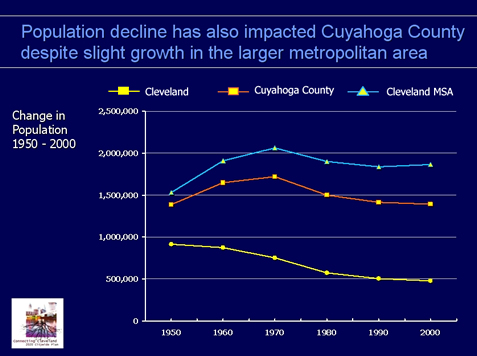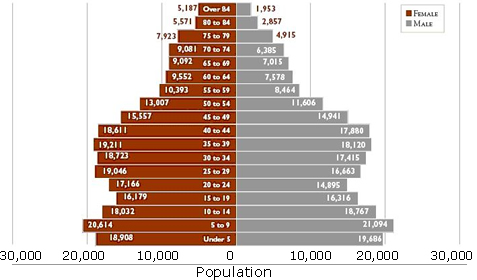How to Get Population Up Again in Cleveland Ohio
Several trends sally that give a clearer pic of the challenge before united states of america, and may as well suggest some areas of greatest vulnerability (or opportunity), where connections with appropriate community assets could be helpful. (Click on highlighted links to admission maps and charts with more than detailed information.)
- Population: Cleveland'due south population has been declining since the 1950s. Thirty-two other U.S. cities are at present larger than Cleveland, once the fifth largest city in America, though the pace of loss slowed considerably in the 1990s. Cleveland'due south Downtown, still, has performed well compared to downtowns in other cities.
In 2000 the Us Census Bureau listed the city's population at 478,403. Cleveland'due south population loss during the 1990s was 5.4% compared to a loss of 8.nine% during the 1980s. The number of households has also declined, admitting at a slower pace than population, and stood at 190,638 in 2000. (See Graph.) Out-migration of residents is the principal reason for Cleveland'south population loss.

Cuyahoga County has too started to see a decline in population. Despite a development pattern in which developed property (red areas on the maps beneath) covered over twice the land surface area in 2000 than it did in 1950, the canton's actual population in those two years was nearly identical. While at that place were xl% more households in Cuyahoga Canton by the end of that 50-year period (Household Trend), the average number of household members had fallen from three.i to 2.39 for the canton, and in the city of Cleveland, from 3.ane to 2.44.
While the core of the metropolitan expanse continued to reject in population, the outer suburbs continued to expand. The four-county metropolitan statistical expanse that includes the city showed an increase of 1.4% or 25,000 people between 1990 and 2000. The design of population growth shows much of the city and inner suburbs declining in population with the growth occurring at the periphery of Cuyahoga County and in surrounding counties. Some census tracts in and effectually Downtown Cleveland, which had previously experienced severe population declines, have shown population increases as a result of new housing construction.Because major employment centers such as Downtown, Academy Circle and industrial districts are located within the city of Cleveland, the number of people that actually work in the city—and thus require many services on a daily basis—is larger than its residential population. The Census Bureau estimates that the urban center'southward daytime population increases to approximately 593,000 due to the influx of commuters to their jobs.
- Ethnicity and Race: Cleveland's growth during the late 19 th and early xx thursday centuries was fueled by immigrants who flocked to the city seeking jobs generated past the industrial revolution. Effectually the middle of the 20 th century the number of immigrants entering the metropolis, as was as well the case with other cities across the country, decreased. But where many cities experienced a rise in immigration during the later 20 th century, especially in terms of Hispanic and Asian immigrants, Cleveland did not come across a dramatic increase in numbers. (Immigration Trend). In fact in 2000 Cleveland had the lowest foreign-born population amongst the targeted cities studied past the Brookings Establishment. Fifty-fifty within the Cleveland area, many suburban communities can boast a higher strange-built-in population than the city of Cleveland. Many new immigrants, when they enter the country, bypass the key city and movement directly to the suburbs. In Cleveland most of the foreign-born are of European or Asian decent.
Over the years an increasing pct of the city's population has been non-white. In 1990 only over half of Cleveland's residents were non-whites. During the 1990s that number grew to 61.2 per centum with the proportion of African-Americans and Hispanics increasing the near.
The segregation of African Americans from whites and of African-Americans from Hispanics exceeds the averages for many big cities. Cleveland's African-American population is concentrated on the east side of the city and in the near eastern suburbs. Hispanics are concentrated in the urban center's west side neighborhoods.
In 2000 over 50% of the City's population was African-American.The city'southward African-American population increased by 10,837 persons, from 235,405 in 1990 to 246,242 in 2000. This increment occurred primarily because births exceeded deaths by more than 26,000. There was a cyberspace out-migration of xv,329 African Americans during the decade, which partially offset the increase in population. Births among whites also exceeded the number of deaths by more than than 9,300, merely that coupled with a cyberspace out-migration of approximately 53,093 resulted in a subtract of 43,747 in the white population. At the neighborhood level, increases and decreases in net migration by race varied widely betwixt 1990 and 2000. Some areas, similar the Broadway and Collinwood neighborhoods, have seen a meaning modify in their racial makeup since 1990.
- Age Demographics: Cities in general tend to be younger places than the suburbs. The median age of Clevelanders in 2000 was 33 as compared to the median for Cuyahoga County of 37.3. Young children age 5 to 9 make upwards the city'southward largest historic period grouping. Baby boomers and young adults also contain a large segment of the population. These age cohorts were also the only ones in which Cleveland saw an increase in population between 1990 and 2000. The composition of the city of Cleveland'south population by age is illustrated in the post-obit population bong.
Cleveland - Population by Age Cohort, 2000

Source: The Brookings Institution
High concentrations of persons nether the age of xviii are plant on the southeast, northeast and nigh w sides of the city. Individuals over the historic period of 65 are concentrated in the metropolis'southward inner suburbs and parts of the east side. Some 70 children and seniors are being supported by every 100 of Cleveland's working-age adults—the second highest percent of economically dependent population institute among the 23 target cities looked at in the Brookings Institute report. - Household Blazon: Compared to other cities, Cleveland has a relatively pocket-sized married-couple family population and a big single-parent family population. The metropolis besides has a loftier pct of unmarried-person households. During the 1990s the urban center of Cleveland saw a drop in married-couple households while it showed a slight increase in other household types. During that same flow the suburbs saw rapid growth in unmarried-parent and unmarried-person households. The suburbs showed a slight growth in married-couples without children but also lost population in married-couple-with-children households.
- Turnover: Cleveland has more long-term residents than many other cities. In 2000 only 16.1% of the city's population had lived in a different metropolis v years before (1995). Among the 23 cities targeted by the Brookings Institution study, Cleveland had the sixth lowest share of "new arrivals".
-
Education: The nation's long-term transition to a service-oriented "knowledge" economy means that places with a disquisitional mass of educated workers have a competitive advantage. In 2000 in Cleveland, almost 1 in 4 children lived in a family unit with no working parents. The percent of Cleveland adults holding a bachelor's degree is the fifth lowest among the nation'southward 100 largest cities. The percentage is rise only is still below the average for the 23 cities compared in the Brookings study.
Cleveland is behind many major cities in academy population and the number of residents with available degrees.The city of Cleveland as well has the second smallest university student population among the 23 cities studied.
- Income: Cleveland'southward median household income in 2000 was $25,928, up 8.three% from its 1990 median income of $23,945. This was twice the national average increment of 4.0% merely even so left Cleveland ranked third lowest among the 100 largest cities in the country. It was also just ii-thirds of Cuyahoga County's median household income of $39,168. The national median income in 2000 was $41,994. Low-income households outnumber loftier-income households in the city by five to 1.
- Poverty: The poverty rate in Cleveland declined somewhat during the 1990s, going from 28.7% in 1990 to 26.3% in 2000. Nevertheless, the child poverty rate (38%), was found to exceed the city average in 2000, while the elderly poverty rate (xvi.8%) came in below the city average. The greatest concentration of poverty is found on the city'southward e and near w sides, where many of the city's Hispanic and African-American residents alive. Not surprisingly, Cleveland had the second highest Hispanic and African-American poverty rates of the 23 target cities in the Brookings Study.
Next Page:Population:Challenges
Source: https://planning.clevelandohio.gov/cwp/pop_trend.php
0 Response to "How to Get Population Up Again in Cleveland Ohio"
Publicar un comentario